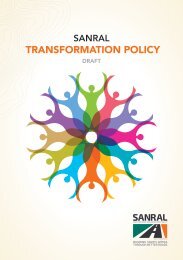Brand-South Africa - Annual report 2015 - 2016
During the past financial year, aligned with its mandate to build pride and patriotism in the Nation Brand, Brand South Africa has worked on initiatives to encourage active citizenship in partnership with its stakeholders in government, business, civil society and identified influential forums to increase the participation of all people, particularly our young people, in building a strong, cohesive Nation Brand. These activities, together with engagements at provincial level on Nation Brand alignment, contribute to social cohesion and a positive Nation Brand. Brand South Africa’s activities took place under the leadership of its new CEO, Amb. Kingsley Makhubela, PhD, who joined the organisation during the year.
During the past financial year, aligned with its mandate to build pride and patriotism in the Nation Brand, Brand South Africa has worked on initiatives to encourage active citizenship in partnership with its stakeholders in government, business, civil society and identified influential forums to increase the participation of all people, particularly our young people, in building a strong, cohesive Nation Brand. These activities, together with engagements at provincial level on Nation Brand alignment, contribute to social cohesion and a positive Nation Brand.
Brand South Africa’s activities took place under the leadership of its new CEO, Amb. Kingsley Makhubela, PhD, who joined the organisation during the year.
Create successful ePaper yourself
Turn your PDF publications into a flip-book with our unique Google optimized e-Paper software.
and south africa <strong>Annual</strong> Report <strong>2015</strong>/<strong>2016</strong><br />
Where irregular expenditure was incurred in the previous<br />
financial year and is only condoned in the following financial<br />
year, the register and the disclosure note to the Financial<br />
Statements must be updated with the amount condoned.<br />
Irregular expenditure that was incurred and identified during<br />
the current financial year and which was not condoned by the<br />
National Treasury or the relevant authority must be recorded<br />
appropriately in the irregular expenditure register. If liability<br />
for the irregular expenditure can be attributed to a person,<br />
a debt account must be created if such a person is liable in<br />
law. Immediate steps must thereafter be taken to recover<br />
the amount from the person concerned. If recovery is not<br />
possible, the accounting officer or accounting authority may<br />
write off the amount as debt impairment and disclose such<br />
in the relevant note to the Financial Statements. The irregular<br />
expenditure register must also be updated accordingly. If the<br />
irregular expenditure has not been condoned and no person<br />
is liable in law, the expenditure related thereto must remain<br />
against the relevant programme/expenditure item, be disclosed<br />
as such in the note to the Financial Statements and updated<br />
accordingly in the irregular expenditure register.<br />
1.19 Segment information<br />
A segment is an activity of an entity:<br />
• that generates economic benefits or service potential<br />
(including economic benefits or service potential relating<br />
to transactions between activities of the same entity);<br />
• whose results are regularly reviewed by management to<br />
make decisions about resources to be allocated to that<br />
activity and in assessing its performance; and<br />
• for which separate financial information is available.<br />
Reportable segments are the actual segments which are<br />
<strong>report</strong>ed on in the segment <strong>report</strong>. They are the segments<br />
identified above or alternatively an aggregation of two or more<br />
of those segments where the aggregation criteria are met.<br />
Measurement<br />
The amount of each segment item <strong>report</strong>ed is the measure<br />
<strong>report</strong>ed to management for the purposes of making decisions<br />
about allocating resources to the segment and assessing its<br />
performance. Adjustments and eliminations made in preparing<br />
the entity’s Financial Statements and allocations of revenues<br />
and expenses are included in determining <strong>report</strong>ed segment<br />
surplus or deficit only if they are included in the measure of<br />
the segment’s surplus or deficit that is used by management.<br />
Similarly, only those assets and liabilities that are included in<br />
the measures of the segment’s assets and segment’s liabilities<br />
that are used by management are <strong>report</strong>ed for that segment.<br />
If amounts are allocated to <strong>report</strong>ed segment surplus or<br />
deficit, assets or liabilities, those amounts are allocated on a<br />
reasonable basis.<br />
If management uses only one measure of a segment’s surplus<br />
or deficit, the segment’s assets or the segment’s liabilities in<br />
assessing segment performance and deciding how to allocate<br />
resources, segment surplus or deficit, assets and liabilities<br />
are <strong>report</strong>ed in terms of that measure. If management uses<br />
more than one measure of a segment’s surplus or deficit, the<br />
segment’s assets or the segment’s liabilities, the <strong>report</strong>ed<br />
measures are those that management believes are determined<br />
in accordance with the measurement principles most consistent<br />
with those used in measuring the corresponding amounts in<br />
the entity’s Financial Statements.<br />
1.20 Budget information<br />
<strong>Brand</strong> SA is subject to budgetary limits in the form of<br />
appropriations or budget authorisations, which is given effect<br />
through authorising legislation, appropriation or similar.<br />
General purpose financial <strong>report</strong>ing by <strong>Brand</strong> SA provides<br />
information on whether resources were obtained and used<br />
in accordance with the legally adopted budget.<br />
The approved budget is prepared on a accrual basis and<br />
presented by programmes linked to performance outcome<br />
objectives.<br />
The approved budget covers the fiscal period from 1 April<br />
<strong>2015</strong> to 31 March <strong>2016</strong>.<br />
The Financial Statements and the budget are on the same<br />
basis of accounting therefore a comparison with the budgeted<br />
amounts for the <strong>report</strong>ing period have been included in the<br />
Statement of comparison of budget and actual amounts.<br />
The Statement of comparative and actual information has been<br />
included in the Financial Statements as the recommended<br />
disclosure when the Financial Statements and the budget are<br />
on the same basis of accounting as determined by National<br />
Treasury.<br />
Comparative information is not required.<br />
1.21 Related parties<br />
<strong>Brand</strong> SA operates in an economic sector currently dominated<br />
by entities directly or indirectly owned by the <strong>South</strong> <strong>Africa</strong>n<br />
Government. As a consequence of the constitutional<br />
independence of the three spheres of government in <strong>South</strong><br />
<strong>Africa</strong>, only entities within the national sphere of government<br />
are considered to be related parties.<br />
Management are those persons responsible for planning,<br />
directing and controlling the activities of <strong>Brand</strong> SA, including<br />
those charged with the governance of <strong>Brand</strong> SA in accordance<br />
with legislation, in instances where they are required to perform<br />
such functions.<br />
Close members of the family of a person are considered to<br />
be those family members who may be expected to influence,<br />
or be influenced by, that management in their dealings with<br />
<strong>Brand</strong> SA.<br />
Only transactions with related parties not at arm’s length or<br />
not in the ordinary course of business are disclosed.<br />
1.22 Events after <strong>report</strong>ing date<br />
Events after <strong>report</strong>ing date are those events, both favourable<br />
and unfavourable, that occur between the <strong>report</strong>ing date and<br />
the date when the Financial Statements are authorised for<br />
issue. Two types of events can be identified:<br />
102











